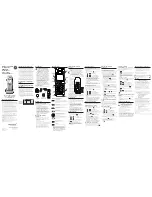
56
Mounting and Operating Instructions CEAG Battery Cabinets
40071860035 (N) March 2016 www.ceag.de
7 Commissioning
Pb
•
•
•
•
•
•
•
•
•
•
•
•
•
Observe these Instructions and keep them located near the battery for future
reference! Work on the battery should only be carried out by qualified
personnel!
Do not smoke!
Do not use any naked flame or other sources of ignition.
Risk of explosion and fire!
While working on batteries wear protective eye-glasses and clothing.
Observe the accident prevention rules as well as EN 50272-2
and EN 50110-1.
Any acid splashes on the skin or in the eyes must be flushed with plenty of
water immediately. Then seek medical assistance . Spillages on clothing
should be rinsed out with water.
Explosion and fire hazard, avoid short circuits.
Avoid electrostatic charges and discharges/sparks!
Cells and blocks are heavy. Always use suitable handling equipment for
transportation.
Handle with care because cells/blocks are sensitive to mechanical shock.
Do not lift or pull up cells/blocks on the poles.
Caution! Metal parts of the battery are always alive, therefore do not place
items or tools on the battery!
Electrolyte is very corrosive. In normal working conditions contact with
electrolyte is impossible. If the cell or block container is damaged do not
touch the exposed electrolyte because it is corrosive.
Non-compliance with operating instructions, installations or repairs made with other than
original accessories and spare parts or with accessories and spare parts not recommended
by the battery manufacturer or repairs made without authorization (e. g. opening of valves)
render the warranty void.
Spent batteries have to be collected and recycled separately from normal household
wastes (EWC 160601). The handling of spent batteries is described in the EU Battery
Directive (2006/66/EC) and their national transitions (UK: HS Regulation 1994 No. 232,
Ireland: Statory Instrument No. 73/2000). Contact your supplier to agree upon the
recollection and recycling of your spent batteries or contact a local and authorized
Waste Management Company.
•
Keep children away from batteries.
81700849
Operating Instruction
Stationary valve regulated lead-acid batteries
A
D
ivisio
n
oE
f xide
T
echnologies
T
T
echnologies
Nominal data
• Nominal voltage U
N
: 2.0V x number of cells
• Nominal capacity C
N
= C
10
; C
20
: 10 h; 20 h discharge
(see type plate on cells/blocks and technical data in these instructions)
• Nominal discharge current I
N
= I
10
; I
20
: C
N
/ 10 h; C
N
/ 20 h
• Final discharge voltage U
f
: see technical data in these instructions
• Nominal temperature T
N
: 20° C; 25° C
Battery type:
Number of cells/blocks:
Assembly and CE marking by:
GNB order no.:
date:
Commissioned by:
date:
Security signs attached by:
date:
1.
Start Up
Check
all
cells/blocks
for
mechanical
damage,
correct
polarity
and
firmly
seated
connectors.
T
o rques
as
shown
in
table
1
apply
for
screw
connectors.
Before
installation
the
supplied
rubber
covers
should
be
fitted
to
both
ends
of
the
connector
cables (pole covers).
Control of insulation resistance:
New batteries:
> 1M
Ù
Used batteries:
> 100
Ù
/ Volt
Connect
the
battery
with
the
correct
polarity
to
the
charger
(pos.
pole
to
pos.
terminal).
The
charger
must
not
be
switched
on
during
this
process, and the load must not be connected.
Switch
on
charger
and
start
charging
following
instruction no. 2.2.
2.
Operation
For
the
installation
and
operation
of
stationary
batteries EN 50 272-2 is mandatory.
Battery
installation
should
be
made
such
that
temperature
differences
between
individual
units do not exceed 3 degrees Celsius (Kelvin).
2.1
Discharge
Discharge must not be continued below the vol-
tage recommended for the discharge time.
Deeper
discharges
must
not
be
carried
out
unless
specifically
agreed
with
the
manufactu-
rer
.
Recharge immediately following complete or
partial discharge.
2.2
Charging
All
charging
must
be
carried
out
according
to
DIN 41773 (IU-characteristic with limit values:
I-constant: ± 2%; U-constant: ± 1%).
Depending
on
the
charging
equipment,
specifi-
cation
and
characteristics
alternating
currents
flow
through
the
battery.
Alternating
currents
and
the
reaction
from
the
loads
may
lead
to
an
additional
temperature
increase
of
the
battery,
and strain the electrodes with possible damages
(see
2.5)
which
can
shorten
the
battery
life.
Depending
on
the
installation
charging
(acc.
to
EN
50272-2)
may
be
carried
out
in
following
operations.
a.) Standby Parallel Operation
Here,
the
load,
battery
and
battery
charger
are
continuously
in
parallel.
Thereby,
the
charging
voltage is the operation voltage and at the same
time
the
battery
installation
voltage.
With
the
standby parallel operation, the battery charger is
capable, at any time, of supplying the maximum
load
current
and
the
battery
charging
current.
The battery only supplies current when the bat-
tery
charger
fails.
The
charging
voltage
should
be set a
cc. to table 2 m
easured at the end ter-
minals of the battery.
Stationary valve regulated lead acid batteries do not require topping-up water. Pressure valves are
used for sealing and cannot be opened without destruction.
AGM-Type
10-32x0,425
G-M5
F-M6
M-M6
M-M8
F-M8
Marathon L/XL
--
--
11 Nm
6 Nm
8 Nm
20 Nm
Marathon M/M-FT
6 Nm
--
11 Nm
6 Nm
--
--
Sprinter P/XP
--
--
11 Nm
6 Nm
8 Nm
--
Sprinter S
--
--
11 Nm
--
--
--
Powerfit S200/S300
--
5 Nm
5 Nm
--
--
--
Powerfit S500
--
--
--
6 Nm
8 Nm
--
•
Cells and blocks are heavy! Make sure they are installed securely. Always
use suitable handling equipment for transportation!
•
Handle with care because cells/blocks are sensitive to mechanical shock.
•
Do not lift or pull up cells/blocks on the poles.





































